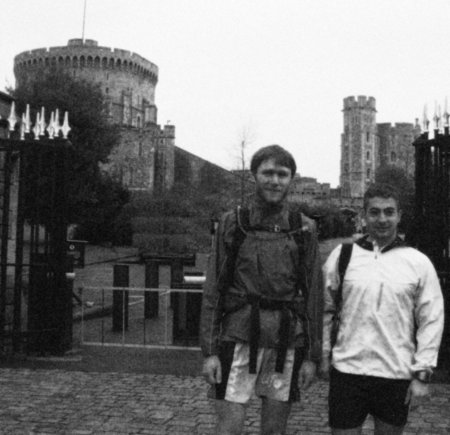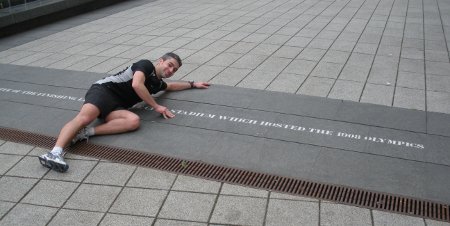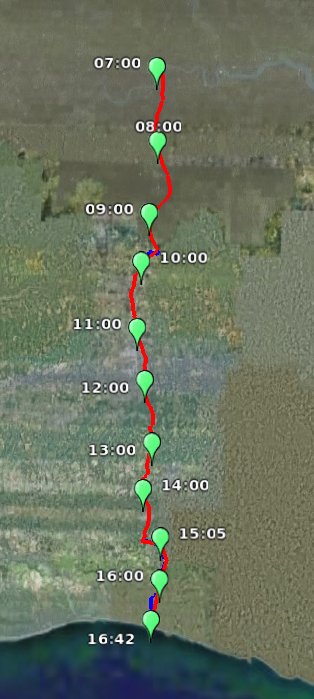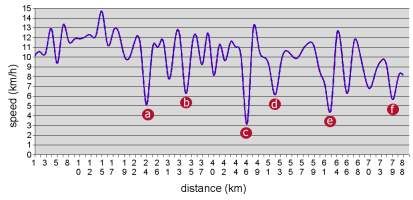Last week-end, I went to
Snowdonia with the
Chameleons in order to attempt the
Paddy Buckley Round. This is an arbitrary tour of most of the highest summits of the Snowdonia National Park. It features 104km for 8,700m of ascent. Runners usually aim to visit all 47 summits in less that 24 hours, but it can alternatively be completed as a 4 days fast hike. Our overall idea was to train for the
Petite Trotte à Léon (PTL) in close-to-reality conditions. In short, a team effort over several days, with the same equipment, and including navigational aspects. With that in mind, the goal wasn't to be as fast as possible, in particular as we would try to spend a night out.
The Moelwynion
We started on Saturday at 12 noon from
Capel Curig towards Moel Siabod and soon realised we wouldn't be fast enough to make it home reasonably early on Sunday. With that in mind, I felt slightly demotivated very early in the run, which is not a good thing in ultra. The main reason for such a slow progress was the very boggy terrain, forcing us to meander a lot and wasting energy at every step. At some point, I managed to sink up to the crouch... Our feet were soaked from the start to the end. The weather was slightly adverse, with occasional drizzle and hill fog, but it wasn't too bad. The
Moelwynion range doesn't seem very touristy compared to the northern mountain ranges and we only saw a few hikers.
Night with the bothy bag
We decided to stop at midnight near Aberglaslyn. The night was rather unpleasant. The bothy bag is a kind of large waterproof bag to be used in case of emergency, and this one is designed for 4 to 6 people to sit. It is very small for 3 people to lie down, and you end up very intimate with your run mates... Good point for team bonding :) .We used our walking poles to raise a bit the "roof". Because of its waterproof nature combined with very poor ventilation, it got very wet inside, and the cold condensation water dripped on our faces the whole night. On top of that, I felt like I couldn't breath properly (not sure whether this is just an impression or if the level of CO
2 was that high), so I ended up moving outside, as Leo did earlier in the night. I got quickly welcomed by a swarm of
midges, which forced me to sleep face down with only my mouth out. Nice.
To make things a bit more lively, Sven woke up as I was still inside and shouted: "Shhhhhhhhhhh!!!", and then "Haven't you heard?". The night was dead silent, but Sven seemed extremely preoccupied, and carried on shouting "Shhhhhhhh!!!". I replied that really there was nothing wrong. Only after a bit more shhhhhhing, Sven drifted back to a quieter mood. He told us later he had dreamed he heard a strange noise, and as he poked me with his arm, he though I was ... a pig attracted by some food in the tent and he wanted to scare it away! Nice to know I feel like a pig when I sleep. Thank you Sven.
Nevertheless, the night helped us to recover, and although we had planned a 4-hour break, we stayed there for five-and-a-half.
The Eifdnydd
Our legs were not too bad in the morning. However, the navigation became harder as we were more tired and not too keen on taking prompt decisions. Moreover, most of the time there was no clear path and apparently very few people were attempting some of the minor summits. Therefore we spent quite some time in route planning, wondering on top of each hill what would be the best route to get to the next one. I can't imagine how we would have done that with a bit more hill fog. On top of that, the midges were following us, buzzing around every time we stopped, and thus forcing quick decisions - I'm not sure whether this is actually a good or a bad thing. We had some repellent, but the evil creatures didn't seem to be aware that it was supposed to scare them away :) Anyway, I'm still itching three days later!
Slippery wet stones near
Y Garn slowed us down a bit further. When we finally arrived in Rhyd-Ddu, Snowdon was in the clouds (as it's been the whole week-end), we lost a bit more motivation due to the miserable weather and eventually decided to come back home...
Split times
Distances and summit list adapted from the
wikipedia page. Note: we actually went through all the summits, but I didn't bother recording the times of some of the minor ones.
| Summit |
Altitude |
Distance |
Clock time |
Time |
| Capel Curig |
200 |
0 |
12:15 |
00:00 |
| Carnedd Moel Siabod |
872 |
4 |
13:30 |
01:15 |
| Clogwyn Bwlch-y-maen |
548 |
7 |
|
|
| Carnedd y Cribau |
591 |
8 |
14:15 |
02:00 |
| Cerrig Cochion |
550 |
11 |
15:15 |
03:00 |
| Moel Meirch |
607 |
12 |
15:30 |
03:15 |
| Ysgafell Wen |
650 |
14 |
|
|
| Mynydd Llynnau'r Cwn |
669 |
14 |
|
|
| Three Tops |
672 |
15 |
16:20 |
04:05 |
| Moel Druman |
676 |
15 |
16:35 |
04:20 |
| Allt-fawr |
698 |
16 |
16:50 |
04:35 |
| Bwlch Cwmorthin |
470 |
19 |
|
|
| Foel Ddu |
458 |
20 |
18:15 |
06:00 |
| Moel-yr-hydd |
648 |
20 |
18:30 |
06:15 |
| Moelwyn Bach |
710 |
23 |
19:15 |
07:00 |
| Craigysgafn |
689 |
23 |
19:30 |
07:15 |
| Moelwyn Mawr |
770 |
24 |
19:45 |
07:30 |
| Cnicht |
689 |
28 |
21:15 |
09:00 |
| Aberglaslyn (arrive) |
5 |
35 |
23:30 |
11:15 |
| Aberglaslyn (depart) |
5 |
35 |
05:00 |
16:45 |
| Bryn Banog |
529 |
38 |
|
|
| Moel Hebog |
782 |
40 |
07:45 |
19:30 |
| Moel yr Ogof |
655 |
41 |
08:25 |
20:10 |
| Moel Lefn |
638 |
42 |
08:45 |
20:30 |
| Y Gyrn |
452 |
44 |
09:45 |
21:30 |
| Mynydd-y-Ddwy-elor |
466 |
44 |
|
|
| Trum y Ddysgl |
709 |
46 |
10:35 |
22:20 |
| Mynydd Drws-y-coed |
695 |
46 |
|
|
| Y Garn |
633 |
47 |
11:30 |
23:15 |
| Rhyd-Ddu |
190 |
50 |
12:15 |
24:00 |
Gear testing
Fundamental pieces of new equipment were tested on the week-end:
- The Quechua S10 Ultralight sleeping bag served its task pretty well. Rather warm despite being slightly damp and packed in only 900g, Decathlon ends up doing good stuff sometimes.
- I bought a OMM Classic Marathon 25L backpack (*), as I needed something a bit bigger than the one used on the UTMB in order to get the bothy and sleeping bags in. It's quite light (725g), well conceived and looks good. Pockets and nettings are easily accessible, relatively waterproof, and a half-length sleeping mat is included in the back! It's also quite comfortable. But I'm not sure how rip-resistant it is, as I managed to tear a bit of netting on a fence already. I have to admit I'm usually tough with my gear.
- The Lifesystems Bothy 4-6 does the job it's designed for. And nothing else.
Lessons
Team effort - no big clash and we managed to stick together the whole time, so that's positive overall. However, we should probably rely more on each other for motivation. Also, I've been leading the way quite a lot, and I guess it would be better if we took more even turns. The decision taking process is far from optimal and rather slow. The route choices were especially difficult, as we had different priorities: shortest distance, safest route, minimal ascent, less technical, ...
Navigation - paper maps should be laminated! My old
OL17 has seen quite a lot already (
then, and
then), and is now turning into
papier maché... Or better, small route cards with pre-marked bearings should be used. I already knew that from the Hardmoors, but it always takes time to learn the lesson.
Night - the bothy bag should be used only if required (that's what it's intented for anyway). We'll probably try to sleep in refuges when/where possible.
Conclusions
In the end, we covered only of 2 the 5 main ranges of summits and half the distance (
ie. 50km). We missed Snowdon, the
Glyderau and the
Carneddau ranges, which are more rocky and probably more similar to the alpine conditions on the PTL. We ran for 18 hours 30 minutes, plus longish break on challenging terrain, so it's not all too bad. But it's a bit disappointing to be fair. We could probably have done the Snowdon range as well in under roughly 24 hours (not considering the night).
According to the guide book, there are three kind of runners attempting the route: those who know every single stone on the route, the navigation geniuses, and those who don't really know what they're doing,
ie. us :) ... This was quite clear. We came there relatively unprepared for the task (route planning, maps, ...). As Leo said as we started running: "Don't forget who's idea it was to do this". Well, it was mine, and I should probably have planned it better.
Anyway, now that we've tried, I can't stay defeated. It's getting personal... There will be more attempts, and there
must be a success one day! Hopefully, further attempts could be much easier, given that we know most of the route (I'm already familiar with the Glyderau and Carneddau).
Ultra team training.
(*) I bought the bag online at
backpackinglight.co.uk, as many retailers were out of stock until late July, and I have to say I'm pretty happy about the company. Apart from the free podcast CD and free sweets shipped with the parcel, they also bother to include a short hand written "personal" note and call you a couple of days later to make sure the parcel has arrived. That's what I call working on customer relationship!





